Tactile’s Knife Company’s First Kitchen Knife Missed on Design, but the Manufacturing is on Point
Tactile Knife Co. have proven themselves pretty soundly in the EDC world with their pens and their recent steps into the folding knife world. So we had high expectations for this santoku. Maybe higher than is reasonable to have for a first-time kitchen knife.
This was a frustrating knife to test and review, because it’s almost really cool. I mean it is cool, but it’s not good enough for me to gush about it, and if they had just made a few key adjustments this would have dropped immediately into our collection of camping chef knives. And while I like the story and idea of the knife, ultimately I didn’t enjoy using it enough to throw into our list of kitchen knives by EDC companies. Although, I do hope to put Tactile Knife Co. in there one day.
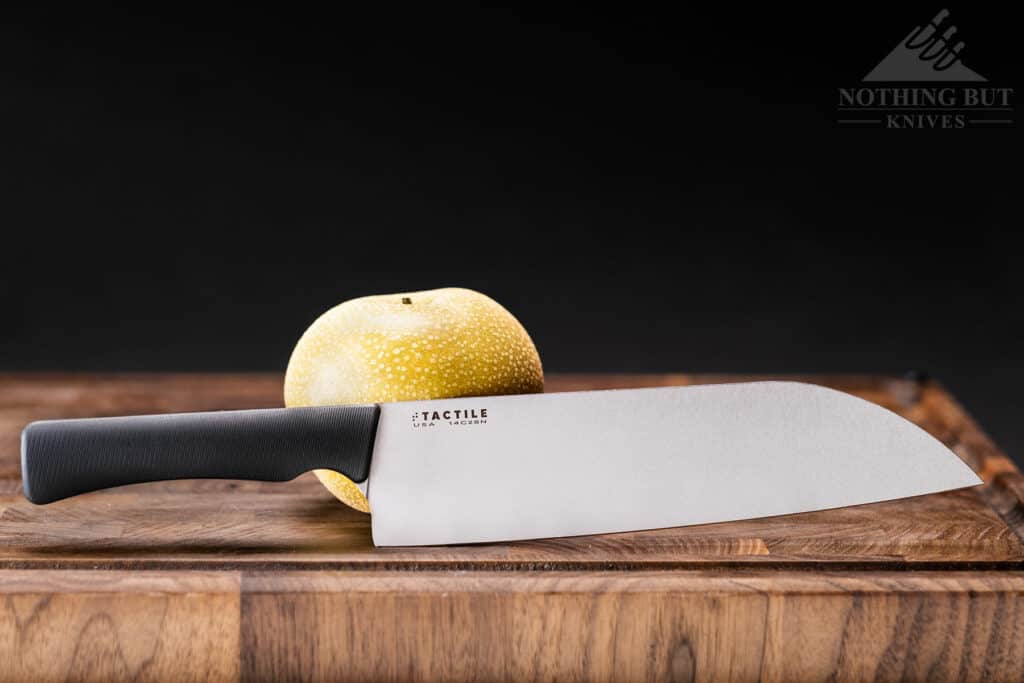
But as it is, this santoku is too long, feels like a toy, and the grind is a confusing mix of thin and blocky. It’s so close to being a good knife, but it falls just a little short both as a dedicated kitchen knife and as a sturdy EDC chef knife to take camping.
That’s not to say there aren’t some cool aspects about it that pique my interest, though. Since this is the first knife like this out of the Tactile factory in Dallas, we got this knife more out of curiosity about the manufacturing quality than the knife design itself (because I’m always curious about US factories). As far as that aspect goes, I was pretty pleased. It’s the design choices that threw me off.
Specifications
| Overall Length: | 12.1” |
| Blade Length: | 7.9” |
| Blade Steel: | 14C28N |
| Hardness: | 60 HRc |
| Blade Thickness: | 2 mm |
| Blade Shape: | Santoku |
| Blade Grind: | Flat w/ 17° angle |
| Handle Length: | 4.2” |
| Handle Material: | Richlite |
| Construction: | Full tang w/ exposed tang |
| Designer: | Will Hodges |
| Made in: | USA |
Pros
| Comfortable handle that’s pretty unique in the kitchen world |
| Very thin edge |
| Damn fine USA manufacturing |
| Tough steel that’s easy to maintain and modify |
Cons
| High priced item |
| Corners of the spine can get uncomfortable on tough cuts |
| Feels cheaper than it actually is |
| Blade control can be a bit of a problem |
Pens to Knives
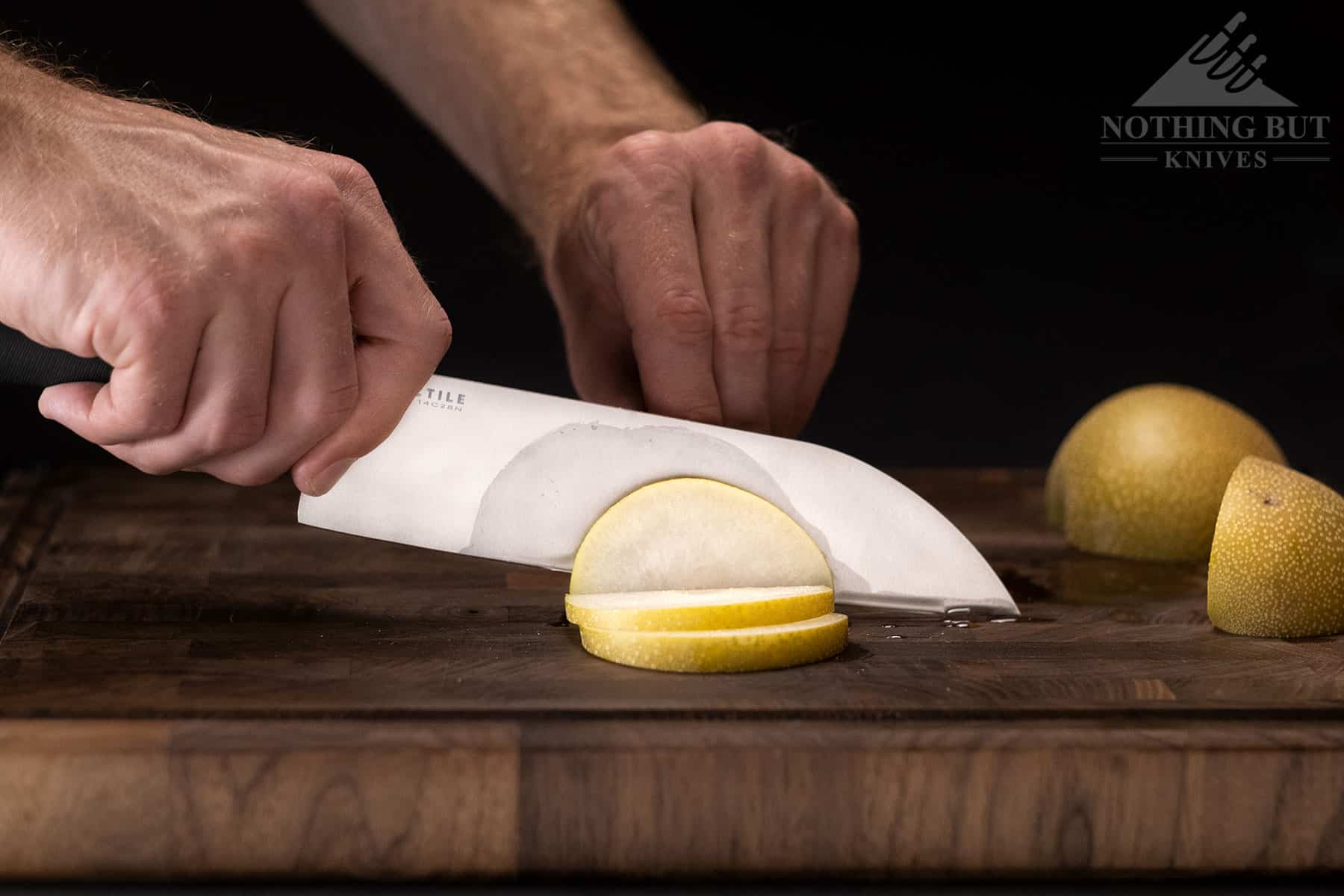
Tactile Knife Co. is a fairly new US manufacturer based in Dallas. It’s the offshoot of Tactile Turn, a high-end pen company which was founded in 2012 by Will Hodges, and has since established itself as a staple in that particular area of the EDC community. I owned the base model of their bolt action pen for about half a year before I picked up the Tactile chef knife, and it’s almost the sole reason I’ve started writing things by hand more (there are, of course, more qualified reviewers who have talked about their pens in the past).
I believe the Tactile knives are coming out of the same factory, and that’s fantastic, because they do not take the position of American manufacturer lightly. They go through pains of using materials and some very sophisticated cutting equipment that’s all sourced from the States.
A lot of the workers in this factory are the same ones who have been turning out Tactile Turn pens, and anyone who’s handled one of those (myself included) can tell you these people are capable of making some pretty damn fancy things.
On top of just straight crafting, Tactile sources as much material as possible from the States, including the handle materials, and make their own pieces including screws and pivots. The only things that are outsourced (according to them) are some raw materials and ball bearings. As far as the raw material goes, I think most of it is actually represented on this chef knife: the 14C28N (which is Swedish), and the Richlite handle, which happens to be sourced from an American company.
While I’m not one to turn away a knife made overseas (most of my favorite knives come from a Taiwanese factory), I always appreciate when a business owner goes through these kinds of pains to keep as much work and materials as close to home as possible, and to do it cleanly and responsibly.
The Pen Inspired Handle
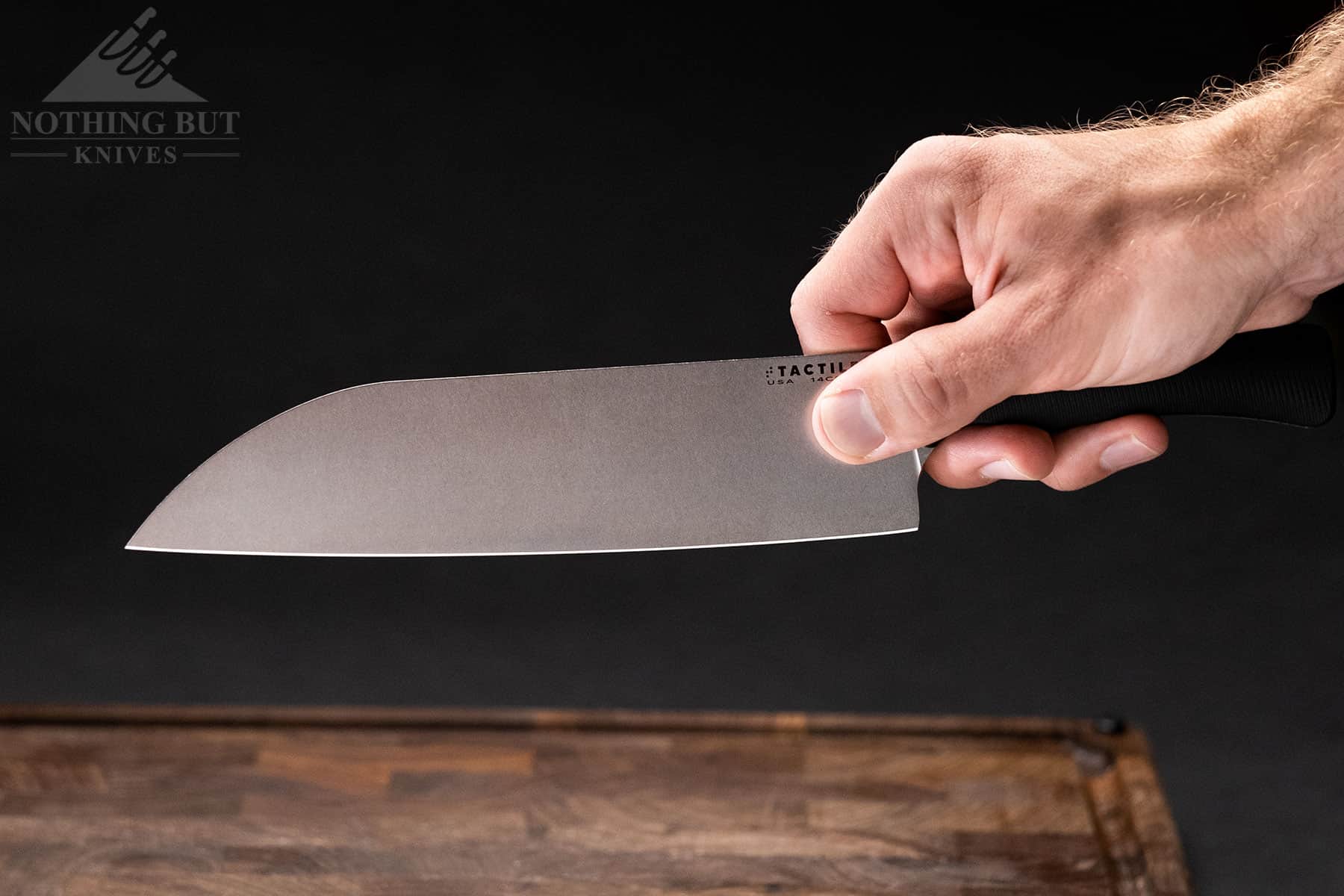
This feels very much like a chef knife made by an EDC knife company that branched off a high-end pen company. A lot of that feeling comes from the way they’ve shaped and textured the handle, which is very similar to the way Tactile Turn shapes and textures their pens. That’s a pretty cool thing, I think, because I like the way their pens feel, and the rounded shape and subtle texturing feels pretty natural on a knife. At first, anyway.
It became troublesome after I started cutting into harder and denser foods. This will come up again when I talk about the blade (that’s its own problem), but the round handle makes it difficult to keep the knife from turning.
In a pinch grip, that’s not a huge, dangerous risk because my fingers are holding the blade in line anyway, but it made me realize just how much the corners and curvatures on other chef knives not only help to keep the thing steady in my hand but to actually control the blade and make minor adjustments in my grip.
I understand that they’re trying to emulate their pens here, but it feels like this handle needs to either be stretched into an oval shape or given ridges so it’s a little bit squared off.
There’s also no thumb ramp or sloping at all at the top of the handle, so it’s not exactly optimized for a pinch grip, but it’s still comfortable in an odd way. Partly because it’s so light, and partly because the width of the handle is just easy to wrap my hand around.
I ended up switching my hand around a lot between a normal pinch grip and a sort of hybrid pinch and loose gorilla grip. Part of that is because the hard corners on the spine create a pretty bad hot spot in a normal pinch grip, so I felt like I had to keep moving my hand back during long sessions of cooking.
The Richlite Stuff
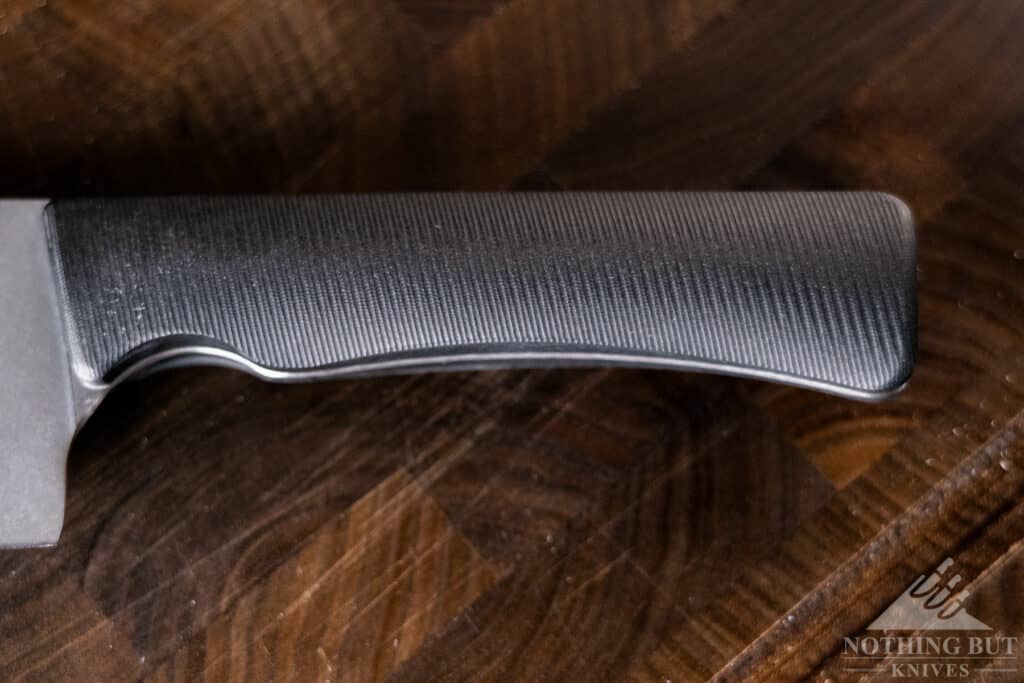
For all the problems I had with the handle, I actually like the idea of using Richlite. It’s a resin infused paper material, so kind of like a mix between Micarta and G-10. It definitely has more of a plasticy feel than I like, and the lightweight nature of it doesn’t make the Tactile chef knife feel very premium, but it’s a tough material that’s been really easy to clean so far.
On top of that, Richlite is a US-based company, being founded (and still operating) in Tacoma, WA, and they make a lot of noise about being a low-emission manufacturer, using “well-managed” forests for material, and recycling wherever they can. I don’t know how much of that they’re actually doing, or how effectively they’re actually trying to do it, but I think the professed attempt is one of the reasons Tactile went with them instead of grabbing onto the slabs of G-10 and FRN flying around between all the other knife makers.
While I personally don’t like this stuff on a kitchen knife, I would love to see more of it on folders and outdoor knives, and I’m glad I got the opportunity to run it through the paces on this knife.
The Thin, Blocky Blade
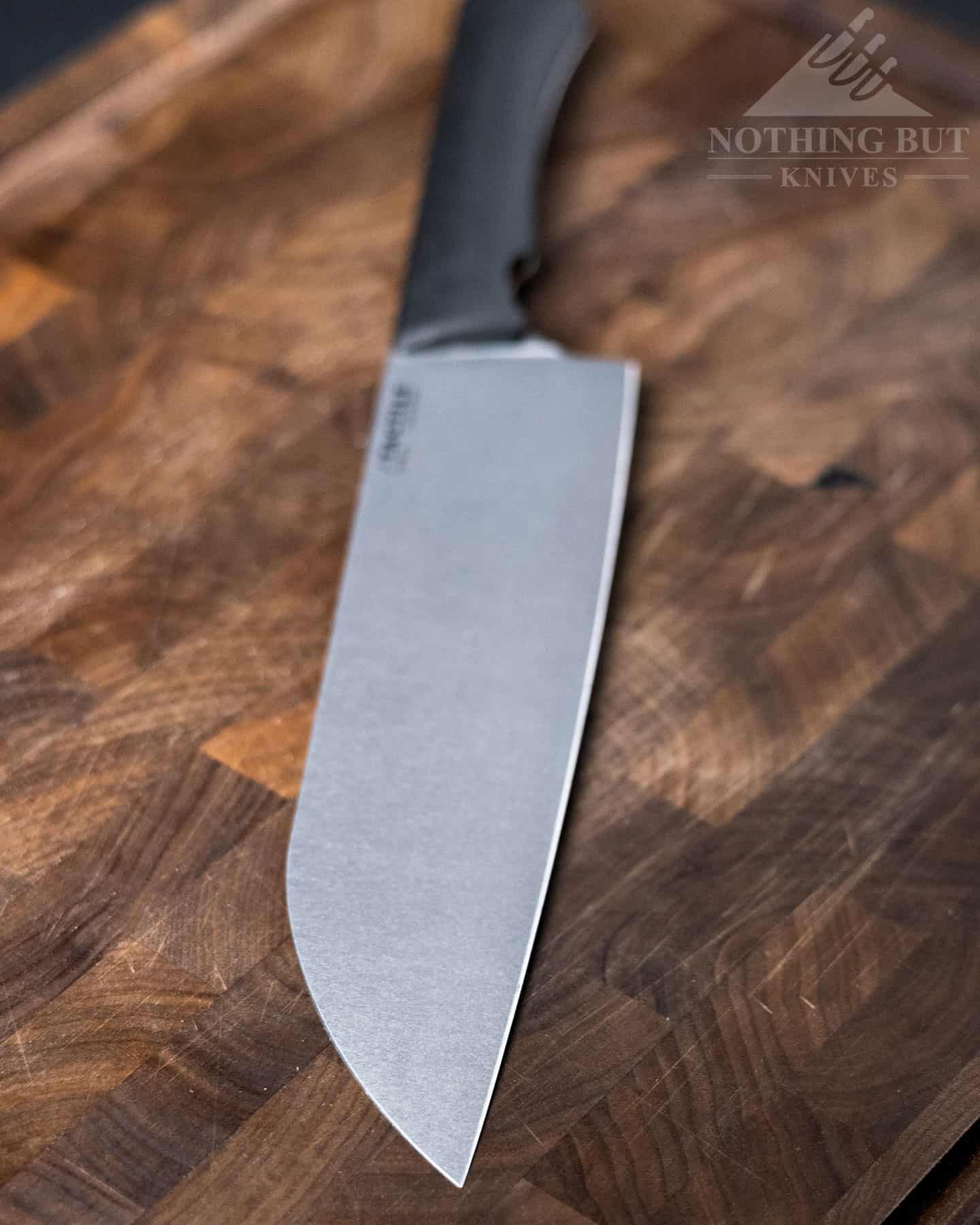
I really didn’t like the way this cut out of the box, and I didn’t particularly love it after I stropped the edge a little either.
It’s sharp: It did fine cutting tomatoes and garlic and onions and all the things a healthy salsa needs. But it just feels… blocky. Which I don’t think is a word I’ve ever used to describe the way a knife cuts before this review, and I’m as confused about it as you.
It could be that the secondary edge is too shallow, and the tapering is too abrupt toward the spine (if there’s any tapering past the secondary edge to begin with). But I’m risking getting into a weird detail that I don’t have enough expertise to explain. All I know is that this knife is sharp and thin, but the cuts feel weird to me.
It’s Not So Thin for the Price
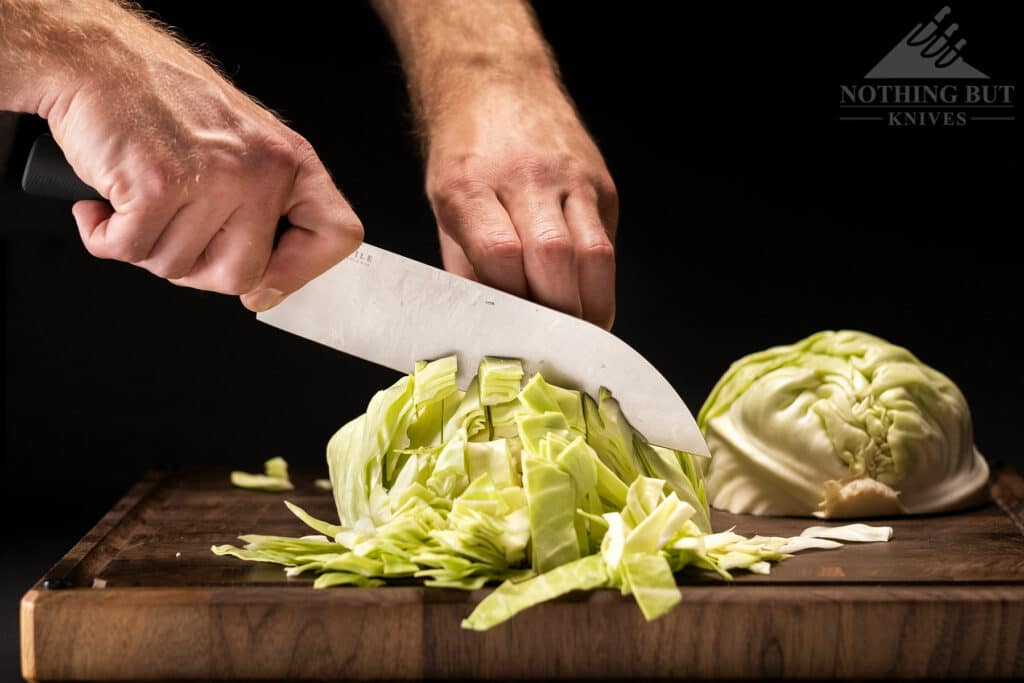
Tactile makes a fuss about how thin the grind and blade stock on this is, but the fact is that they’ve priced their kitchen knife to the point that it’s competing with some incredibly thin, smooth cutting knives.
They ground the edge to 17 degrees, which is pretty thin when compared to some western chef knives, and much thinner than your typical EDC knife. But these days 17 is getting to be a larger number in the kitchen world. Even Wusthof is getting their stuff down to around 15 degrees.
The grind is technically nice on this, though. Toward the spine and tip, the whole thing is perfectly straight, and they’ve still kept a little bit of curvature to the edge to help facilitate and finish cuts. So they’ve executed the basics of a really good chef knife here. There’s just something in the tapering and behind-the-edge geometry that keeps it from cutting like a properly high-end chef knife.
The Tough Razor Steel and the Reprofiling Option
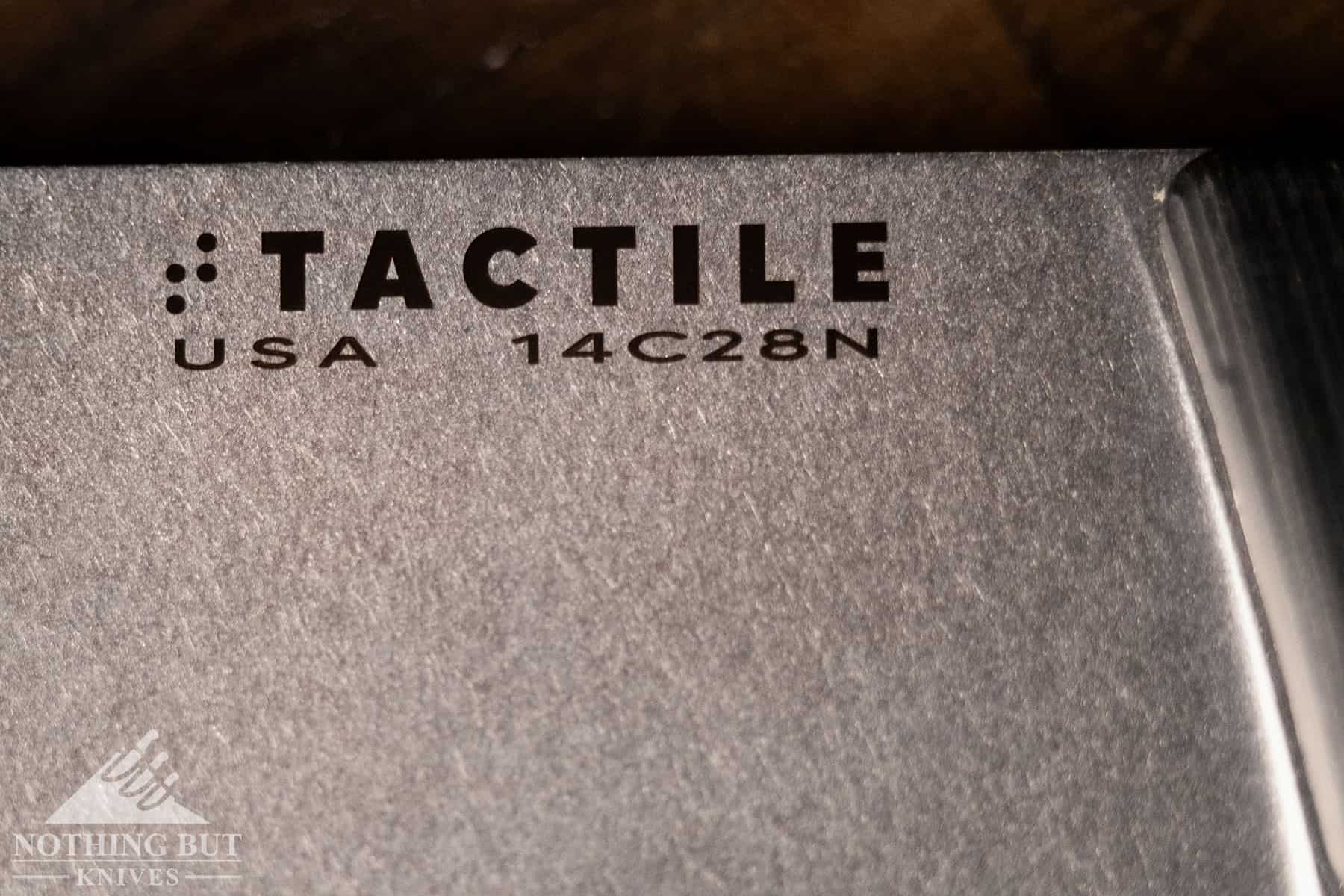
It strops up easy, and all around behaves the way 14C28N should when it’s been heat treated well. I’d even say it holds its edge longer than what I’ve experienced with this Sandvik stuff in the past.
But even though it cuts a lot cleaner after being stropped, I still don’t love the feel of it. It just has a way of feeling like it goes out of control suddenly. Not wildly out of control to the point that I’m worried about cutting myself, but I do end up with an apple slice that was a little wider than I intended, or an uneven set of lines when I’m dicing an onion.
This gets more pronounced when I’m using the tip (so it comes up a lot when I’m dicing onions). It’ll cut fine for a while, but the second it touches down on the smooth side of the onion or into the meat of a potato, it feels like it wants to either turn or bend. This hasn’t resulted in me cutting myself or anything, but it has made some of my cuts sloppier than usual (which is saying a lot), and it just doesn’t feel nice.
My guess is that this is a combination of three things: one is the shallow ground making the cuts feel “blocky”, two is that the blade is just too long so it starts feeling bendy if I try cutting through something too dense or starchy (like an apple or potato) too high up on the blade.
Three is that I’m just not that proficient with santoku knives, or kitchen knives in general. I’ve reviewed my share of kitchen cutlery over the years, and I can do some basic cuts to keep myself fed, but I don’t consider myself a proficient cook, so all of this should be taken with a grain of salt. And a little cumin, And maybe a squeeze of citrus because someone told me once that makes everything taste better.
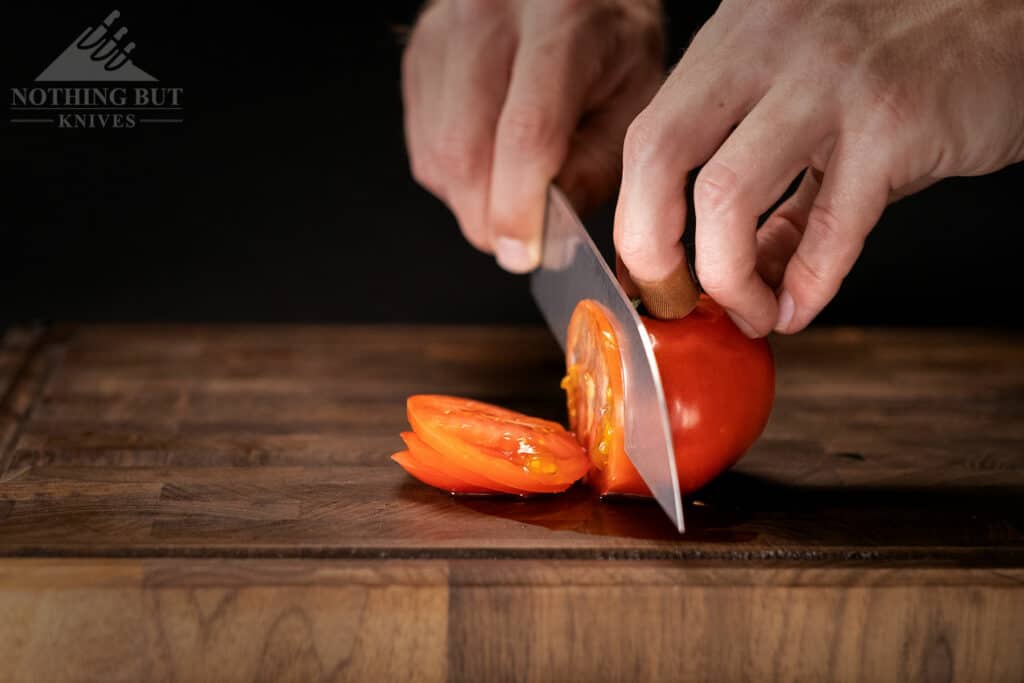
For all the problems I have with the blade, though, they all make the steel choice shine. 14C28N Sandvik can literally take a razor edge. Razors are actually what it was developed for in the first place. It’s not going to have incredible wear resistance. The general consensus I’ve heard (and experienced myself) is that the edge retention lands somewhere a little beneath 154CM. That’s not incredibly impressive in this age of super powder steels, but it’s sturdy and easy to maintain. Considering the kind of people who are probably buying this thing, this was a good choice on Tactile Knife Co’s part.
For a stainless steel, this stuff is incredibly easy to play with and reprofile. So if you get this and don’t like the way it cuts, just take it to a heavy grit stone (or a grinder, or a knife sharpener) and get the thing into a geometry that works for you. The blade is already pretty thin, but an experienced hand should be able to smooth out the bevel enough to get it into proper cutting shape.
The Blade Shape and Size
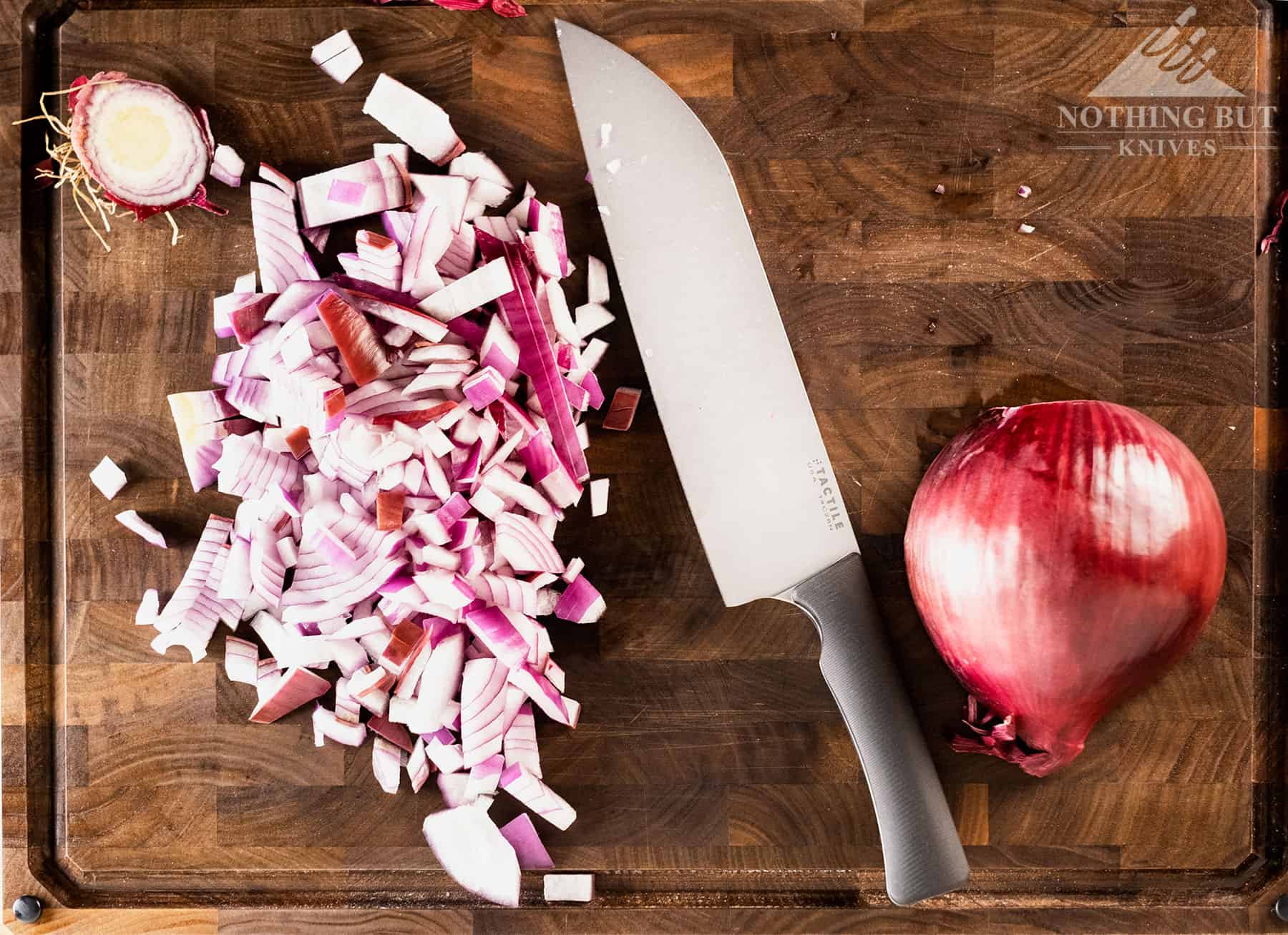
I’m a little confused by the choice of blade style here. I don’t know if the decision to run with an 8 inch santoku blade was the result of market research or if this is what the owner normally uses in his kitchen, but my little forays into the kitchen knife world have shown me that gyutos and western chef knives are still kings in the popularity department.
On the one hand, I wouldn’t care that much, but if they made this 6 inches it would have been a significantly better knife. For one, they could sell it a little cheaper (I assume), and it wouldn’t have as much of a bending problem near the tip. It would also be easier to store and make a sheath for, which is what I really want for this knife.
Price and Comparison
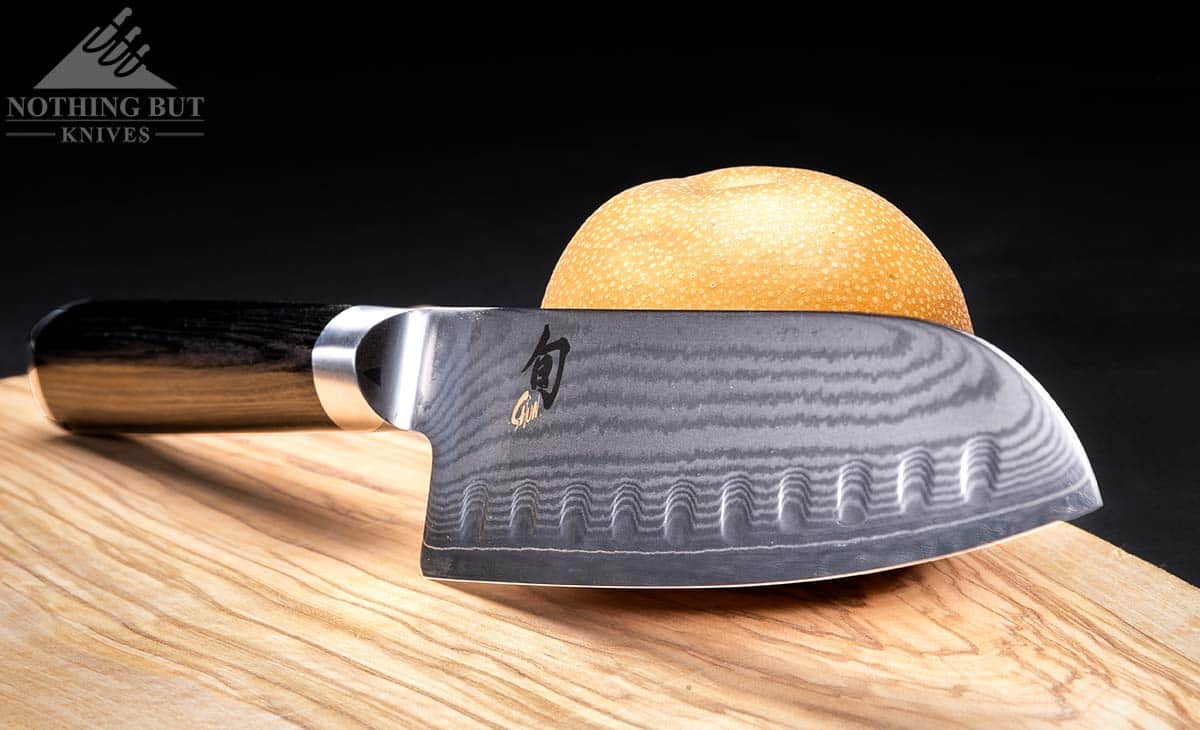
Tactile has entered dangerous territory with the $180 price tag here.
That puts it in sight of both the Enso Santoku and the Shun Classic santoku, and it does not cut as well as either out of the box. In fact, the price and styling puts it against a big group of Japanese cutlery and high-end knife sets that makes for tough comparison. Although to be fair, Tactile’s knife is longer than any santoku I’ve reviewed before, and all my alternative suggestions have blades that are significantly harder to sharpen.
For a really comfortable handle, I’d recommend going with the Enso HD santoku (or the Yaxell Tsuchimon, which is roughly the same thing from the same factory). Handles kind of their specialization, although their blades look pretty sweet. They tend to be wide behind the edge for Japanese cutlery, but still mean slicers.
For a really smooth slicer, though, the Shun Classic is a good way to go. This will cut pretty much how a Japanese kitchen knife should, and I found it to be pretty comfortable, although the D-shaped handle isn’t my favorite thing.
The problem is, both of those suggestions tend to be overpriced. So for similarity in handle and weight and a reasonable price point, I’d actually point you toward Global’s Classic series. I’ve only handled their gyuto, but the handles and balance are about the same on all their knives. More importantly, they cut beautifully.
Stepping outside the strict bounds of the kitchen, I think the real contender is the Off Grid Grizzly. It carries the same EDC feeling of the Tactile chef knife but it’s more honest about its intended context and comes in a kydex sheath. The Grizzley is a thicker knife, but I found it much more pleasant to cut with. The main downside is the AUS-8 steel is a couple steps down from the Tactile’s 14C28N blade.
COnclusion: The EDC Vibe and Arguable Value of Buying American
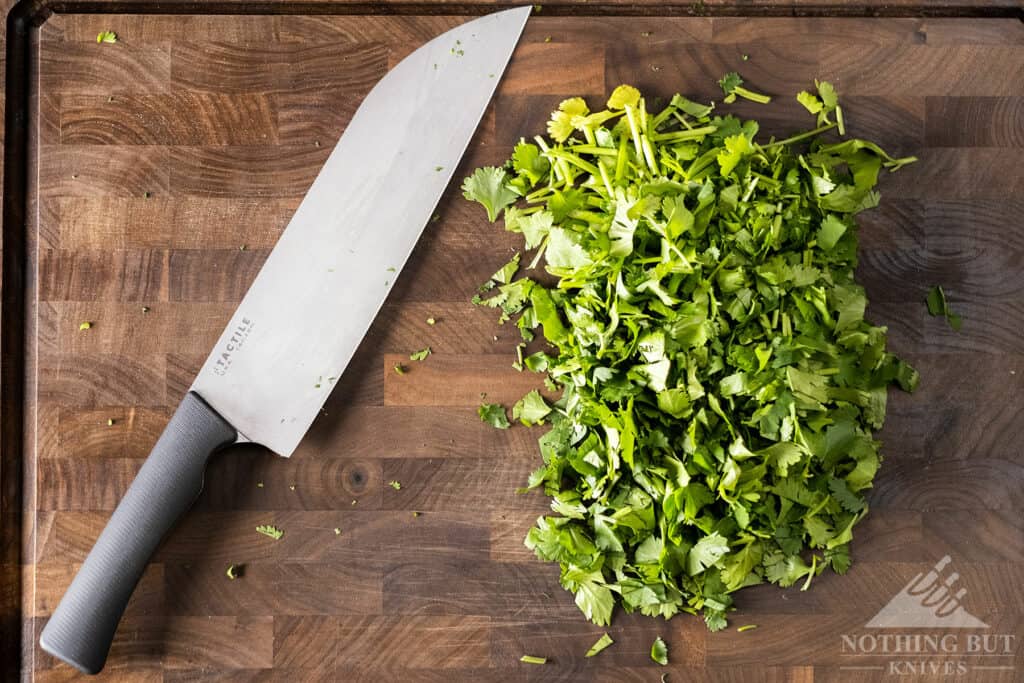
Messing with this knife really just makes me wish they had made a more EDC-centric fixed blade, because that is very much the area that Tactile excels at.
It’s not that this is a bad knife. It’s sharp and comfortable, and has a respectable steel that I feel very comfortable with in terms of durability and maintenance. But I can feel that EDC mindset in this thing. The handle is screaming to be on a gentleman’s carry knife, and the material and texture would be great to have outdoors in wet conditions.
I love that Tactile is playing with a design that’s a little outside their wheelhouse, but I have a lot of trouble recommending this knife at this price point.
The biggest selling point for me is that it’s well made and comes from a US-based factory that prioritizes local sources and strict quality control. I want more things to come out of this factory because they do good work. But if Tactile is gonna keep making kitchen cutlery, I’d like to see them either workshop the designs into a more accessible price point, or make a knife that can make at least a reasonable argument against a Shun or Global.
